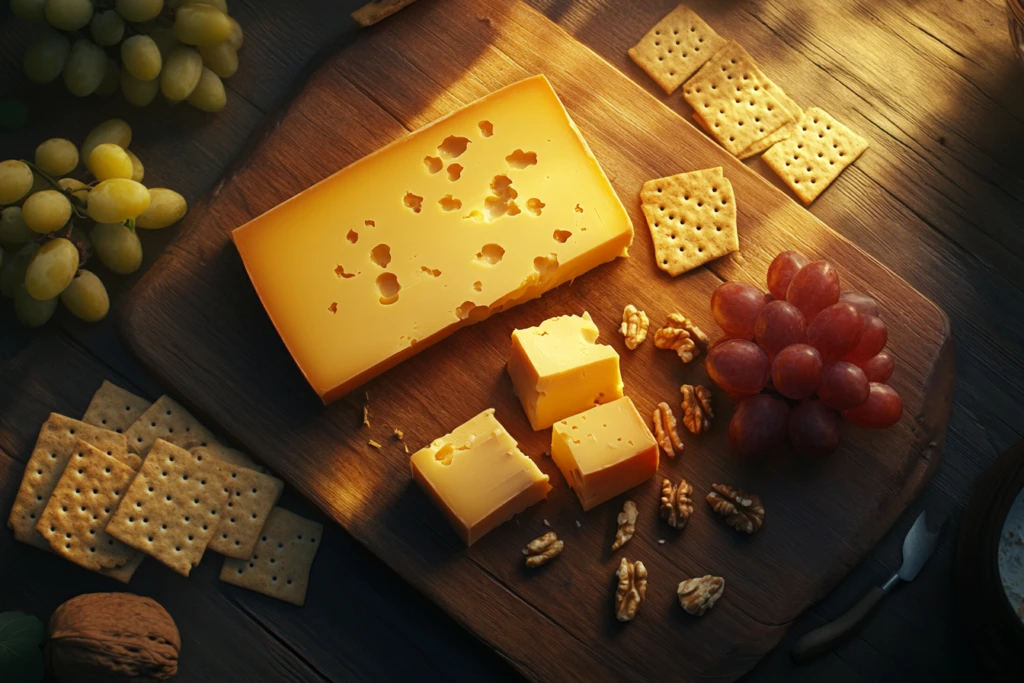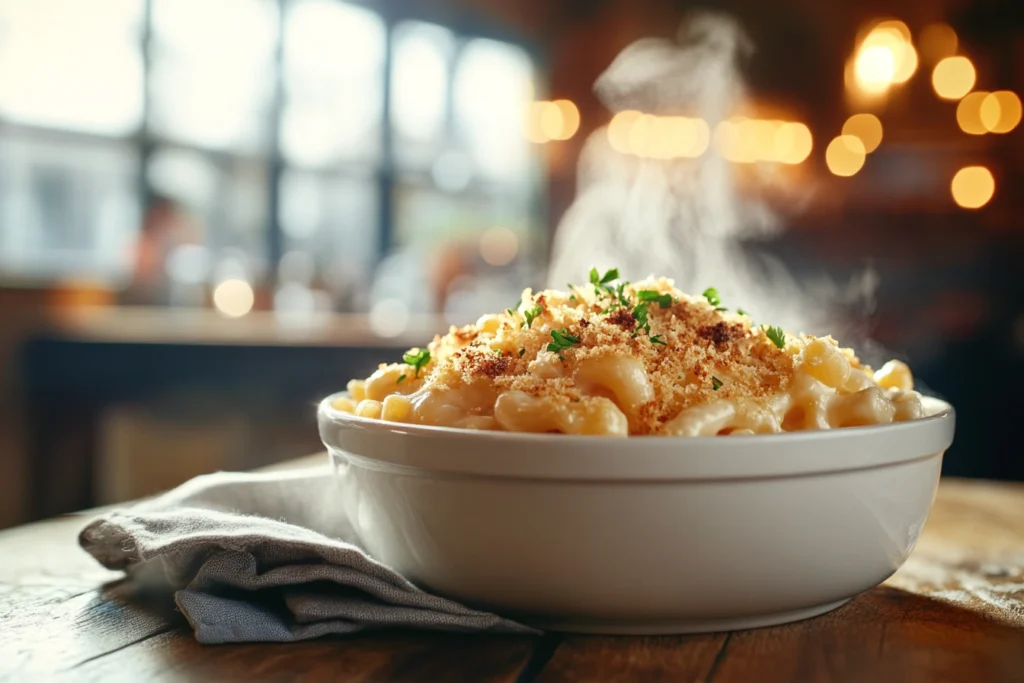1. Introduction to Cheddar Cheese
Cheddar cheese is one of the most popular and versatile cheeses in the world. Known for its creamy texture and rich flavor, it is a staple in kitchens globally. Whether enjoyed on a cheese platter, melted into comfort foods, or added to gourmet dishes, cheddar cheese has earned its reputation as a culinary favorite.
Originating in England over 800 years ago, cheddar cheese has evolved into a variety of flavors and textures, ranging from mild and creamy to sharp and crumbly. Its ability to melt easily and complement a wide array of dishes makes it a go-to ingredient for both home cooks and professional chefs.
In this article, we’ll take a deep dive into the history, types, nutritional value, culinary uses, and storage tips for cheddar cheese. By the end, you’ll also find answers to frequently asked questions about this iconic cheese.
2. History and Origin of Cheddar Cheese
2.1 Early Beginnings
Cheddar cheese traces its roots back to Cheddar Village in Somerset, England, where it was first produced during the 12th century. According to legends, a milkmaid accidentally left milk in a cave, where it fermented naturally, resulting in the creation of this flavorful cheese.
The cool caves of Somerset provided the ideal conditions for aging cheese, giving it a rich texture and distinct flavor. Over time, the production process became more refined, with controlled aging techniques ensuring consistency.
2.2 Evolution Over Centuries
As cheddar cheese gained popularity, it spread across Europe and America. British settlers brought the cheese-making techniques to the United States, where it became a household favorite.
While artisanal production remains popular, modern methods have also enabled mass production, making cheddar widely accessible. However, authentic version from England continues to carry Protected Designation of Origin (PDO) status, preserving its heritage.
2.3 Global Popularity
Today, cheddar cheese is produced in countries like Australia, New Zealand, and the United States, adapting to local flavors and preferences. Whether it’s aged for sharpness or blended with spices, cheddar remains a global favorite in both traditional recipes and modern cuisines.
Cheddar cheese’s rich history and global influence have made it a symbol of culinary excellence. From humble beginnings in Somerset to becoming an international staple, it continues to stand out as one of the most beloved cheeses worldwide.
3. Types of Cheddar Cheese
Cheddar cheese comes in a variety of flavors, textures, and aging profiles, making it suitable for different tastes and recipes. Its versatility allows it to be used in both simple snacks and gourmet dishes.
3.1 Mild Cheddar

Mild cheddar is aged for about two to three months, resulting in a smooth and creamy texture. Its flavor is subtle and slightly buttery, making it ideal for sandwiches, burgers, and quesadillas. Due to its mildness, it is often used in recipes that require melting, such as mac and cheese or casseroles.
This type is also perfect for kids or those who prefer a less intense flavor profile. It pairs well with crackers, fresh fruits, and roasted vegetables.
3.2 Sharp Cheddar
Sharp cheddar is aged for six to twelve months, giving it a stronger, tangier flavor than its mild counterpart. Its firmer texture and bold taste make it suitable for grating over baked dishes, pasta, and soups.
Sharp cheddar works well in recipes that require a pronounced cheese flavor, such as cheesy breadsticks, sauces, and dips. It also pairs nicely with pears, apples, and honey for a sweet and savory combination.
3.3 Extra Sharp Cheddar
Extra sharp cheddar is aged for over a year, resulting in an intense, robust flavor and crumbly texture. It is often used in recipes that call for a more mature taste, such as soufflés and gourmet cheese boards.
Because of its aged nature, extra sharp cheddar is commonly enjoyed in small portions. It is perfect for pairing with cured meats, pickles, and bold condiments like mustard or chutneys.
3.4 White Cheddar vs. Yellow Cheddar
White cheddar is made without added coloring, allowing it to maintain its natural pale color. In contrast, yellow cheddar is colored with annatto, a natural food dye that gives it a vibrant hue.
Both varieties taste similar, but white cheddar is often perceived as being more natural. Yellow cheddar is more common in commercial products like cheese slices and spreads.
White cheddar is favored for upscale dishes like gourmet mac and cheese, while yellow cheddar is popular in comfort foods such as nachos and cheeseburgers.
3.5 Smoked and Flavored Cheddar
Smoked cheddar is infused with a smoky flavor by being aged in a smokehouse or treated with liquid smoke. It pairs well with barbecue dishes, burgers, and sandwiches.
Flavored cheddar varieties, such as those infused with herbs, garlic, or chili peppers, add an extra layer of complexity. These versions are perfect for snack platters or adding a twist to traditional recipes.
4. Nutritional Value and Health Benefits of Cheddar Cheese
Cheddar cheese is not only delicious but also packed with nutrients that contribute to a balanced diet. From protein and calcium to vitamins and probiotics, it provides several health benefits when consumed in moderation.
4.1 Macronutrients and Calories
Cheddar cheese is an excellent source of high-quality protein, providing about seven grams per one-ounce serving. Protein is essential for building and repairing tissues, making it a valuable addition to muscle-building diets.
It also contains healthy fats, which are necessary for absorbing fat-soluble vitamins and maintaining energy levels. Although it is calorie-dense, with approximately 110 calories per serving, it can be included in calorie-controlled diets when eaten in moderation.
Carbohydrate content is minimal, with less than one gram per serving, making it suitable for low-carb and ketogenic diets.
4.2 Vitamins and Minerals
Cheddar cheese is rich in calcium, which supports strong bones and teeth. It also provides phosphorus, a mineral that aids in energy production and bone health. Together, these nutrients make cheddar an excellent choice for maintaining skeletal strength. Learn more about the nutritional benefits of cheese and how it fits into a balanced diet.
Vitamin B12, present in it, supports nerve function and red blood cell formation. Zinc and selenium contribute to immune health and act as antioxidants, protecting cells from oxidative stress.
The presence of vitamin A further boosts eye health and supports immune function, making it both a tasty and nutritious option.
4.3 Probiotic and Digestive Benefits
Aged cheddar cheese contains probiotics that promote gut health by supporting the growth of beneficial bacteria. These probiotics improve digestion, boost nutrient absorption, and strengthen the immune system.
The aging process also reduces the lactose content in it, making it easier to digest for individuals with mild lactose intolerance.
4.4 Dietary Considerations
Cheddar cheese fits into several dietary plans, including ketogenic, low-carb, and high-protein diets. Its high-fat content provides energy, while its low-carb profile makes it ideal for people managing blood sugar levels.
However, its sodium content requires moderation, especially for individuals monitoring their salt intake. Opting for low-sodium varieties can help balance flavor and health considerations.
Cheddar cheese is also a good option for vegetarians, as most modern varieties use microbial rennet instead of animal rennet during production.
5. Culinary Uses of Cheddar Cheese
Cheddar cheese’s rich flavor and smooth melting properties make it one of the most versatile ingredients in the kitchen. Whether served cold, melted, or baked, it can elevate a wide range of dishes.
5.1 Popular Dishes

Cheddar cheese is a staple in comfort foods, adding both flavor and creaminess.
- Mac and cheese: A classic dish where melted cheddar creates a creamy and satisfying texture.
- Grilled cheese sandwiches: Melts beautifully for a crispy, gooey sandwich.
- Cheeseburgers: Adds a sharp, tangy flavor that pairs perfectly with beef.
- Nachos: Melts evenly over chips, making it a favorite for game-day snacks.
- Soups and stews: Enhances creaminess in dishes like cheddar broccoli soup.
Its ability to complement both hot and cold dishes has made it a go-to ingredient for home cooks and professional chefs alike.
5.2 Cheese Boards and Pairings
Cheddar cheese is a standout component in cheese boards. It pairs well with a variety of flavors, from sweet to savory, making it a centerpiece for gatherings.
- Fruits: Apples, pears, and grapes balance cheddar’s tanginess with natural sweetness.
- Nuts: Walnuts, almonds, and pecans add crunch and complement its creamy texture.
- Crackers: Serve with whole-grain crackers or toasted baguette slices for a satisfying snack.
- Spreads: Pair with honey, fig jam, or chutney to enhance its flavor.
5.3 Cooking Tips and Techniques
- Shred cheddar for faster melting in soups and sauces.
- Use aged cheddar to add bold flavor to baked dishes like lasagna and casseroles.
- Allow cheddar to come to room temperature before serving on cheese boards to enhance its flavor.
- Add grated cheddar to breadcrumbs for a crispy, cheesy topping on baked pasta dishes.
When using cheddar in cooking, combining it with other cheeses like mozzarella or Parmesan can add complexity and creaminess.
5.4 Unique Recipe Ideas
Cheddar cheese is not limited to traditional recipes. It can also be incorporated into more creative dishes:
- Cheddar-stuffed meatballs: Adds a gooey center to classic meatballs.
- Cheese biscuits: Combines sharp cheddar with herbs for savory snacks.
- Cheddar soufflés: Provides structure and flavor to airy, baked dishes.
- Breakfast burritos: Melted cheddar pairs perfectly with eggs and veggies.
- Cheddar potato gratin: Layers of sliced potatoes and melted cheese create a creamy side dish. (Check out other cheese-inspired recipes for more ideas.)
6. Storage and Preservation Tips for Cheddar Cheese
Proper storage of cheddar cheese ensures its flavor and texture remain fresh, whether it’s used immediately or saved for future recipes. Following these tips will help prevent spoilage and extend its shelf life.
6.1 Short-Term Storage
For daily use, cheddar cheese should be stored in the refrigerator at a temperature of 34–38°F (1–3°C).
- Wrap the cheese in wax or parchment paper to allow it to breathe and prevent it from drying out.
- Place the wrapped cheese in an airtight container or resealable plastic bag for added protection.
- Avoid storing it near strong-smelling foods, as it can absorb odors.
Proper wrapping prevents excessive moisture buildup, which can lead to mold growth.
6.2 Freezing Cheddar Cheese
Cheddar cheese can be frozen, but it’s best to freeze shredded or cubed cheese rather than whole blocks to preserve its texture.
Steps for freezing:
- Grate or cube the cheddar cheese before freezing for easier portioning.
- Place it in a freezer-safe bag, removing as much air as possible to prevent freezer burn.
- Label the bag with the date and store it for up to six months.
Thaw frozen cheddar cheese in the refrigerator overnight for best results. Note that previously frozen cheese works better for cooking rather than slicing due to slight texture changes.
6.3 Signs of Spoilage
Cheddar cheese, like any dairy product, should be checked regularly for signs of spoilage.
Look for:
- Visible mold growth, especially colors other than the typical blue or white molds used in cheese aging.
- Discoloration or dark spots.
- Ammonia-like odors or sour smells, which indicate spoilage.
- Slimy or excessively hard textures.
If mold appears on a block of cheddar, cut at least one inch around and below the affected area. However, if the mold is widespread, discard the cheese entirely.
6.4 Make-Ahead and Meal Prep Tips
Cheddar cheese can also be prepped in advance for quick use in recipes.
- Shred and portion cheddar into meal-sized quantities before refrigerating or freezing.
- Use pre-shredded cheese for quick toppings on baked dishes or salads.
- Prepare cheddar-based sauces in batches and freeze them in airtight containers for reheating later.
Prepping cheese in advance not only saves time but also ensures you always have a flavorful ingredient ready for cooking or snacking.
7. Frequently Asked Questions (FAQs)
7.1 What Makes Cheddar Cheese Yellow?
Cheddar cheese is naturally white or pale cream in color. The yellow hue seen in some varieties is due to the addition of annatto, a natural food coloring derived from the seeds of the achiote tree. Annatto does not affect the flavor but is used primarily to create visual appeal. White cheddar, on the other hand, is left in its natural state without added color.
7.2 How Long Does Cheddar Cheese Last?
When stored properly in the refrigerator, cheddar cheese can last up to three to four weeks after opening. Unopened blocks can last even longer, typically one to two months. Frozen cheddar cheese can be stored for up to six months, although its texture may slightly change after thawing, making it more suitable for cooking than slicing.
7.3 Can You Eat Cheddar Cheese on a Diet?
Yes, cheddar cheese fits into several diet plans, including ketogenic, low-carb, and high-protein diets. Its high protein content supports muscle growth, while its low-carb nature makes it ideal for controlling blood sugar levels. However, due to its calorie density and sodium content, it’s recommended to consume it in moderation.
7.4 Does Aging Affect Cheddar’s Taste?
Aging plays a significant role in the taste and texture of cheddar cheese. Younger cheddar has a mild and creamy flavor, while aged cheddar becomes sharper, crumblier, and more complex. The aging process enhances its flavor profile, making it ideal for cooking, snacking, or cheese boards.
7.5 Is Cheddar Cheese Lactose-Free?
Aged cheddar cheese contains very little lactose, as most of it is broken down during the aging process. This makes it easier to digest for individuals with mild lactose intolerance. However, people with severe dairy allergies should consult a doctor before consuming it.
8. Conclusion
Cheddar cheese remains one of the most versatile and beloved cheeses, offering a variety of flavors and textures to suit any preference. From mild and creamy options to sharp and aged varieties, it is a staple ingredient that enhances both simple and gourmet dishes.
Its rich nutritional profile, including protein, calcium, and probiotics, makes it a healthy addition to balanced diets. With the right storage methods, cheddar cheese can be preserved for long-term use, ensuring freshness and flavor whenever needed.
Whether it’s melted into comfort foods, crumbled over salads, or paired with fruits and nuts on a cheese board, cheddar cheese continues to be a culinary essential. Its adaptability, flavor, and nutritional value make it a timeless favorite for home cooks and food enthusiasts alike.
